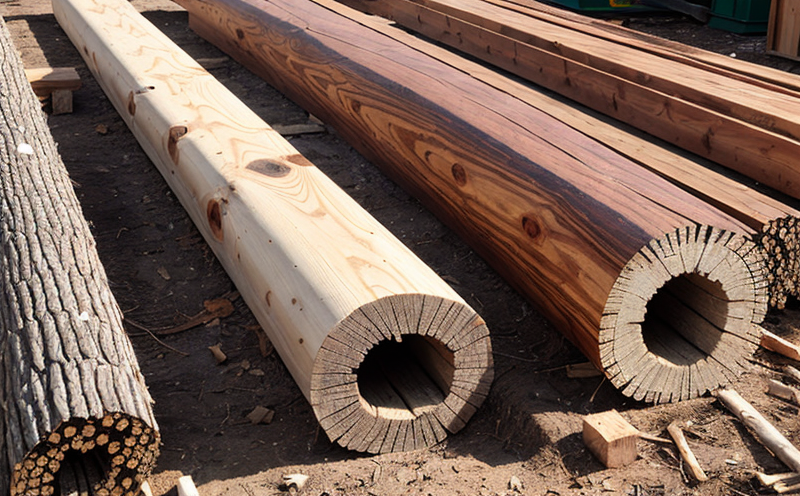Wood Durability & Preservation Testing
The durability and preservation of wood are critical factors in ensuring the longevity and sustainability of wooden structures used across various sectors. In agriculture and forestry, where wood is commonly utilized for construction, fencing, and packaging materials, the ability to assess these properties accurately is essential.
Wooden components can be exposed to a myriad of environmental conditions that may reduce their service life over time. These include moisture, fungal attack, insect infestation, and microbial decay. Therefore, wood durability testing focuses on evaluating how well wooden products withstand such adverse conditions while also ensuring they meet preservation standards through treatments like impregnation with preservatives or application of coatings.
Our laboratory specializes in providing comprehensive wood durability & preservation testing services tailored specifically for the agriculture and forestry sectors. We use advanced analytical techniques including gravimetric methods, cross-section analysis under controlled humidity levels, and resistance measurements against decay fungi and insects to determine the effectiveness of treatments applied during manufacturing processes.
The importance of accurate and reliable testing cannot be overstated when it comes to ensuring compliance with relevant international standards such as ISO 6323-1 (Grading of timber for structural use) and ASTM D1412 (Standard test method for resistance of wood preservatives to fungal attack). By adhering strictly to these guidelines, we ensure our clients receive consistent results that are both repeatable and accurate.
Our experienced technicians work closely with quality managers, compliance officers, R&D engineers, and procurement professionals from around the globe. Together, they help develop robust strategies aimed at improving product performance through enhanced durability and better preservation solutions.
Applied Standards
The wood durability & preservation testing conducted by our laboratory is guided by a variety of internationally recognized standards designed to ensure consistency and accuracy in assessing the quality and longevity of wooden materials. Some key references include:
- ISO 15190:2004 – Determination of resistance to decay of wood
- ASTM D1412 – Standard test method for resistance of wood preservatives to fungal attack
- ISO 15177:2019 – Determination of resistance to insect attack of wood products and wood-based materials
- ASTM D1130 – Standard practice for determining resistance of wood preservatives to fungal attack using the salt-spray method
These standards provide a framework within which we conduct our testing, ensuring that every sample is subjected to rigorous evaluation according to internationally accepted criteria.
Why Choose This Test
- Comprehensive Evaluation: Our tests cover all aspects of wood durability and preservation, providing a holistic view of your product's performance under real-world conditions.
- Expertise and Experience: Leveraging years of experience in agricultural & forestry testing, our team applies their knowledge to deliver precise results every time.
- State-of-the-Art Facilities: Equipped with cutting-edge equipment, we ensure that each test is conducted under the most favorable conditions possible.
- Compliance Assurance: By following stringent international standards, you can be confident that your products meet all necessary regulatory requirements.
- Custom Solutions: Tailored testing programs designed to address specific client needs and challenges.
- Quick Turnaround Times: Efficient processes mean faster results without compromising on quality or accuracy.
Selecting wood durability & preservation tests from our laboratory ensures that you get the most accurate, reliable data available today. This allows you to make informed decisions about product development and ensure long-term success in your industry.
Use Cases and Application Examples
The applications for wood durability and preservation testing are wide-ranging but particularly important within agriculture and forestry due to the extensive use of wooden materials. Here are some examples:
- Fence Posts: Wooden fence posts can be subject to significant weathering conditions, making it crucial to assess their resistance to decay caused by fungi or insects.
- Agricultural Structures: Buildings used in farming operations need strong wood components that can withstand harsh environmental factors like rain, snow, and sunlight exposure.
- Packaging Materials: Wooden crates and pallets must be robust enough to protect agricultural products during transportation but also resistant to moisture absorption which leads to rotting.
- Timber Floors: In indoor environments such as barns or workshops, wooden flooring needs to endure heavy foot traffic while remaining stable against termite infestations.
By utilizing our expert wood durability & preservation testing services, you can ensure that your products are fit for purpose and designed to last longer under challenging conditions. This not only enhances customer satisfaction but also contributes positively towards sustainable practices in the agricultural sector.





